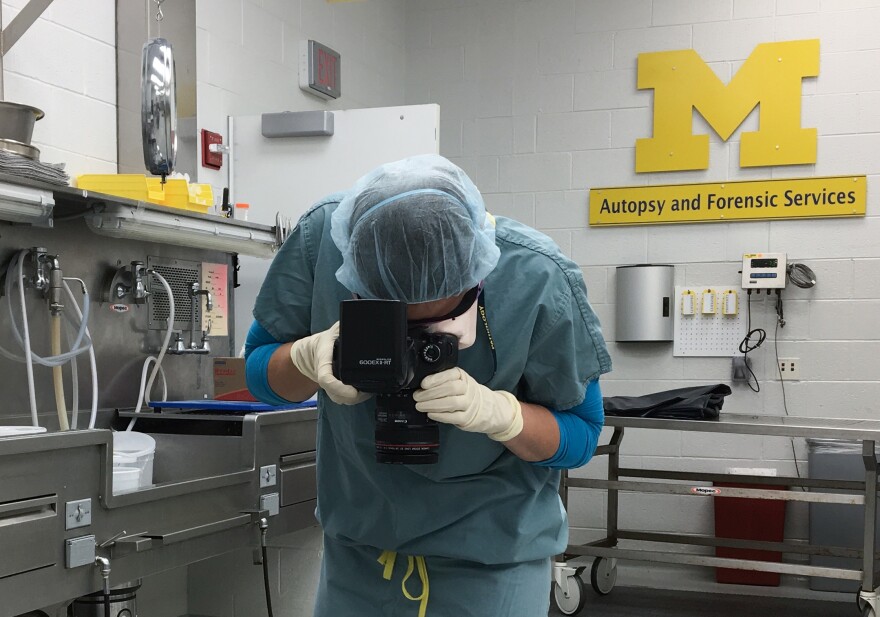Photography is an art form that can capture people, places, and things in the most imaginative of ways. It takes a creative and learned mind to succesfully negotiate the world of biomedical and forensic photography. That accurately describes Lisa Belanger Neal. Lisa is a biomedical photographer in Autopsy & Forensic Services in the Department of Pathology at the University of Michigan Hospital. Hear about her work in a conversation with WEMU's David Fair and Arts Alliance CEO Deb Polich in this week's "creative:impact."

Creative industries in Washtenaw County add hundreds of millions of dollars to the local economy. In the weeks and months to come, 89.1 WEMU's David Fair and co-host Deb Polich, the President and CEO of The Arts Alliance, explore the myriad of contributors that make up the creative sector in Washtenaw County.
About Lisa Belanger Neal
Biomedical photographer
Autopsy & Forensic Services
Department of Pathology, University of Michigan Hospital
Biomedical Communications and Fine Art
Oakland University
Bachelor of Arts (B.A.)
Journalism
Certified Retinal Angiographer (CRA)
Optical Coherence Tomography Certified (OCT-C)

Biomedical photographers take detailed pictures or videos of such things as bacteria and viruses, surgical procedures, hospital patients, body parts and autopsies. They use a variety of camera and printing techniques; one such example is photomicrography, a technology which converts microscopic images into those viewable to the naked eye. Biomedical photographers utilize computer applications and software, like In-Design, PowerPoint, Photoshop, Flash and Dreamweaver.
Some biomedical photographers specialize in ophthalmic photography, or the use of specialized equipment, such as fundus cameras, to photograph and document areas of the eye, including the iris, retina and cornea. Other photographic specialties include operating room, dental and specimen photography.
Credentials
The Ophthalmic Photographers' Society's (OPS) Board of Certification provides credentials for specialists in ophthalmic photography. To earn an OPS credential, photographers must pass examinations and submit work samples.
Biomedical photographers produce images that may be used for medical and scientific research, reports and publications. They must have detailed knowledge of scientific processes and use photography to document information relevant to science. Professionals in this field are required to have postsecondary training in biomedical photography.
U-M biomedical photographer helps families heal
By Safiya Merchant
The University Record
Faculty/Staff Spotlight
Topic: Campus News

Every day at Michigan Medicine’s University Hospital, Lisa Belanger Neal uses a camera to demystify death.
A biomedical photographer for Autopsy & Forensic Services under the Department of Pathology, Neal provides photographic documentation during autopsies for hospitals. She also takes photos for cases evaluated by the medical examiner’s offices in Washtenaw and Livingston Counties.
Her photos are used for court cases and death investigations, as well as teaching tools for medical education.
Additionally, Neal’s photos contribute to the research missions of the International Center for Automotive Medicine and the Michigan Legacy Tissue Program, which study crash injuries and cancer tumors, respectively.
Neal previously worked as an ophthalmic biomedical photographer for the Kresge Eye Institute and Henry Ford Health System.
Looking back, she says she fell in love with photography as a journalism student at Oakland University. During her last semester, a friend advised her to take a photography class to broaden her skill set and value as a journalist.
As someone who likes to stay organized, she said the methodical process of photography was appealing.
On a typical day at the University Hospital morgue, the photographer begins her shift checking emails to determine what constituents need services, from burning CDs of images for law enforcement and watermarking images for legal purposes to assisting residents and fellows with presentation and poster images.
A self-described “biomedical curator,” Neal said she is responsible for categorizing and organizing all Autopsy and Forensic Service images.
On average, the morgue conducts three autopsies a day, and Neal takes a variety of photos depending on the case, including those of external and internal body parts.
She said she generally doesn’t get squeamish on the job.
“I always put myself on the other side,” Neal said. “I know why we’re doing an autopsy — we’re trying to help families get answers. It is an honor to play a small role in a family’s healing process.”
Neal said her favorite part of her job is working with medical residents and helping them improve how they take photographs to document their cases.
“I like teaching because it helps me solidify the way that I do things,” she said.
The weekly Spotlight features faculty and staff members at the university. To nominate a candidate, email the Record staff at urecord@umich.edu.
Neal uses photography as a teaching tool also on her Twitter page, where she engages the broader pathology and medical education communities in discussions about the human body.
For her #WhatIsItWednesday Twitter entries, she posts pictures of gross specimens and ophthalmic photographs and asks her online audience to play along and engage in discussion.
“It’s really nice because many medical education programs don’t have the opportunity view gross anatomy like this,” she said.
Looking back on her time at the morgue, Neal said the memories that really stand out are the ones where she can directly impact a family during their most difficult times. “Gifting a family a delicate photograph of a hand, footprint or tattoo, it’s nice to be able to offer something that can assist in the grieving process.”

Resources:
U-M Hospital Department of Pathology
Non-commercial, fact based reporting is made possible by your financial support. Make your donation to WEMU today to keep your community NPR station thriving.
Like 89.1 WEMU on Facebook and follow us on Twitter
— David Fair is the WEMU News Director and host of Morning Edition on WEMU. You can contact David at 734.487.3363, on twitter @DavidFairWEMU, or email him at dfair@emich.edu






